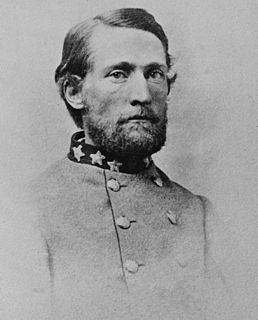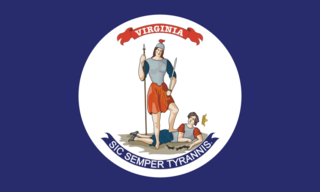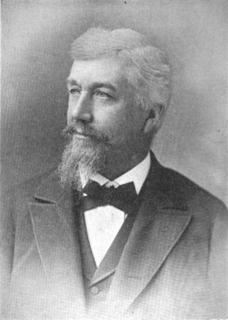
John Singleton Mosby, also known by his nickname, the "Gray Ghost", was a Confederate army cavalry battalion commander in the American Civil War. His command, the 43rd Battalion, Virginia Cavalry, known as Mosby's Rangers or Mosby's Raiders, was a partisan ranger unit noted for its lightning-quick raids and its ability to elude Union Army pursuers and disappear, blending in with local farmers and townsmen. The area of northern central Virginia in which Mosby operated with impunity became known as Mosby's Confederacy. After the war, Mosby became a Republican and worked as an attorney, supporting his former enemy's commander, U.S. President Ulysses S. Grant. He also served as the American consul to Hong Kong and in the U.S. Department of Justice.

The Battle of Middleburg took place from June 17 to June 19, 1863, in Loudoun County, Virginia, as part of the Gettysburg Campaign of the American Civil War.

Waterford is an unincorporated village and census-designated place (CDP) in the Catoctin Valley of Loudoun County, Virginia, located along Catoctin Creek. Waterford is 47 miles (76 km) northwest of Washington, D.C., and 7 miles (11 km) northwest of Leesburg. The entire village and surrounding countryside is a National Historic Landmark District, noted for its well-preserved 18th and 19th-century character.

The Loudoun Valley is a small, but historically significant valley in the Blue Ridge Mountains located in Loudoun County in Northern Virginia in the United States.
The Battle of Mile Hill was a cavalry skirmish during the American Civil War, that took place just north of Leesburg, Virginia, on September 2, 1862. It preceded the occupation of the town by the Army of Northern Virginia just prior to its crossing of the Potomac River starting the Maryland Campaign.
Loudoun County, Virginia, was destined to be an area of significant military activity during the American Civil War. Located on Virginia's northern frontier, the Potomac River, Loudoun County became a borderland after Virginia's secession from the Union in early 1861. Loudoun County's numerous Potomac bridges, ferries and fords made it an ideal location for the Union and Confederate armies to cross into and out of Virginia. Likewise, the county's several gaps in the Blue Ridge Mountains that connected the Piedmont to the Shenandoah Valley and Winchester were of considerable strategic importance. The opposing armies would traverse the county several times throughout the war leading to several small battles, most notably the Battle of Balls Bluff.

The Loudoun Rangers, also known as Mean's Rangers for their commander, Samuel C. Means, was a partisan cavalry unit raised in Loudoun County, Virginia, that fought for the Union during the American Civil War. The Rangers have the distinction of being the only unit raised in present-day Virginia to serve in the Union Army.

The 43rd Virginia Cavalry Battalion, also known as Mosby's Rangers, Mosby's Raiders, or Mosby's Men, was a battalion of partisan cavalry in the Confederate Army during the American Civil War. Noted for their lightning strike raids on Union targets and their ability to consistently elude pursuit, the Rangers disrupted Union communications and supply lines.

Elijah Viers "Lige" White was commander of the partisan 35th Battalion of Virginia Cavalry during the American Civil War. His men became commonly known as "White's Comanches" for their war cries and sudden raids on enemy targets.
The Skirmish at Miskel Farm, also known as the Fight at Miskel Farm or Gunfight at Miskel Farm, was a skirmish during the American Civil War. It took place April 1, 1863, near Broad Run in Loudoun County, Virginia, between Mosby's Rangers and the 2nd Pennsylvania Cavalry as part of Mosby's operations in Northern Virginia. The 2nd Pennsylvania surprised and attacked the Rangers, who were bivouacked on the farm of Thomas Miskel. The Rangers successfully defended the attack and subsequently routed the 2nd Pennsylvania, inflicting heavy casualties and taking many prisoners.

The Battle of Unison or Battle of Union refers to a series of American Civil War cavalry skirmishes in Loudoun County, Virginia, between October 31 – November 2, 1862, between the Confederate forces of J.E.B. Stuart and various units of the Union Army of the Potomac. Although driven from the field in individual engagements, Stuart accomplished his mission to delay the enemy and screen the movements of the retreating Army of Northern Virginia.
The Battle of Loudoun Heights was a small cavalry skirmish during the American Civil War between John Mosby's Rangers and Major Henry A. Cole's 1st Potomac Home Brigade Maryland Cavalry on January 10, 1864, in Loudoun County, Virginia. Cole's Cavalry successfully defended a night raid against their camp on Loudoun Heights. The fight was one of the first engagements in which Union forces held their own against Mosby's vaunted partisans.
Heaton's Crossroads, also known as the Purcellville Wagon Raid, was an American Civil War skirmish that took place between Federal cavalry under Brig. Gen. Alfred N. Duffié and Confederate infantry under Maj. Gen. John C. Breckinridge on July 16, 1864, near present-day Purcellville, Virginia in Loudoun County as part of the Valley Campaigns of 1864. The action was tactically inconclusive.

The 35th Virginia Cavalry Battalion, also known as White's Battalion, White's Rebels and the Comanches, was a Confederate cavalry unit during the American Civil War raised by Elijah V. White in Loudoun County, Virginia in the winter of 1861-62. The battalion was initially raised as border guards along the Potomac River below Harpers Ferry but were ultimately mustered into regular service as part of the Laurel Brigade. Despite this, they continued to play a conspicuous role in the ongoing partisan warfare in Loudoun throughout the war. The battalion was particularly notable during the 1863 Gettysburg Campaign, when it played a prominent role in the Battle of Brandy Station and subsequently conducted a series of raids on Union-held railroads and defensive positions in Maryland and Pennsylvania. The 35th was the first Confederate unit to enter Gettysburg, Pennsylvania.
The Battle of Charlestown was a small engagement between Confederate cavalry forces under Brig. Gen. John D. Imboden and the Union forces under Col. Benjamin L. Simpson on October 18, 1863, at Charles Town, West Virginia, as part of the Bristoe and Mine Run Campaigns, resulting in a Confederate victory.
The action at Mount Zion Church was a cavalry skirmish during the American Civil War that took place on July 6, 1864. The skirmish was fought between Union forces under Major William H. Forbes and Confederate forces under Colonel John S. Mosby near Aldie in Loudoun County, Virginia as part of Mosby's Operations in Northern Virginia. After successfully raiding the Union garrison at Point of Rocks, Maryland, Mosby's Rangers routed Forbes's command, which had been sent into Loudoun County to engage and capture the Rangers. The fight resulted in a Confederate victory.
The Fight at Aldie was a small cavalry skirmish between Confederate forces under Major John S. Mosby and Union forces under Major Joseph Gilmore and Captain Franklin T. Huntoon in Aldie, Virginia, on March 2, 1863, as part of Mosby's Operations in Northern Virginia during the American Civil War. The fight which resulted in a Confederate victory was significant in that it was the first action of Mosby's Rangers within their operating territory in the central Loudoun Valley. In the fight Mosby and his men displayed many characteristics that would become their hallmark including the attack on numerically superior force while inflicting disproportionate casualties to those received.
The George's Schoolhouse Raid was a Confederate partisan raid led by local guerrilla John Mobberly on the Union garrison at Lovettsville in Loudoun County, Virginia on January 17, 1865, during the American Civil War. The raid was tactically inconclusive. After surprising the sleeping garrison, the Confederates were driven away by superior force, taking with them only a few horses and prisoners. The raid is notable for being the last partisan action in Loudoun County involving Elijah V. White's 35th Battalion of Virginia Cavalry.
The Affair at Glenmore Farm was a small cavalry skirmish that took place October 16, 1862 in Loudoun County, Virginia between Confederate forces under First Lieutenant Frank Myers and Union forces under General John Geary during the American Civil War. The skirmish resulted in a Union victory.
The Harmony Skirmish was a small engagement of the American Civil War between Confederate forces under Colonel John Mosby and Union forces under Colonel Marcus Reno on March 21, 1865, near the village of Harmony in Loudoun County, Virginia. A union raiding party, that was sent into Loudoun County to eliminate Confederate partisans, was ambushed by Mosby's Rangers near the village of Harmony. After inflicting light casualties on the Federals, the Rangers were unable to drive off the numerically superior and better equipped force and were compelled to withdraw. The skirmish, which was the last major action of the war within Loudoun, was tactically inconclusive.










